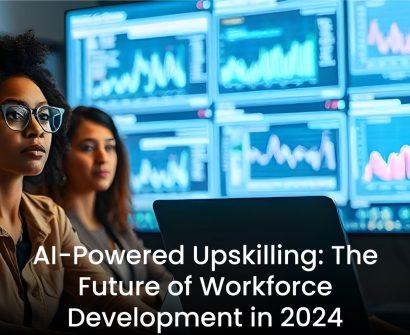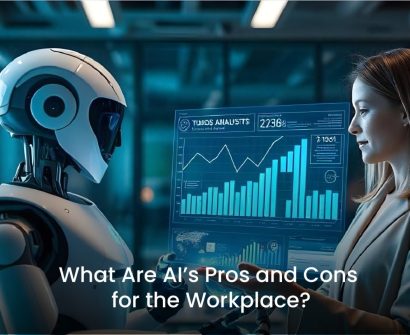
How Can AI Be Used in the Workforce?
Providing creative solutions for productivity, employee engagement, and decision-making, artificial intelligence (AI) is revolutionizing today’s workforce in previously uncommon terms. AI is not only improving operational efficiency but also reshaping job roles and workplace relationships, which companies keep changing. Let’s explore the potential applications of artificial intelligence in the workforce and the reasons behind its increasing significance in modern companies.
How AI is Transforming the Modern Workforce
Artificial intelligence (AI) is currently a major driver of innovation in the workplace rather than a future idea. From improving output to allowing better decision-making, artificial intelligence is changing how companies run. Companies that successfully integrate artificial intelligence into their daily activities see notable gains in general performance, staff involvement, and efficiency.
From automating menial chores to offering valuable data for strategic choices, artificial intelligence is having effects in every sector. The issue now is “how” artificial intelligence may be used to maximize potential rather than “if” it will transform the workforce.
The Benefits of AI in the Workforce
For people as well as businesses, AI presents a great number of advantages. AI frees staff people’ time from monotonous jobs so they may concentrate on more creative and fun ones. For businesses, artificial intelligence increases operational efficiency, reduces expenses, and provides insightful data that helps to guide decisions. By means of tailored development and training initiatives, AI solutions may also raise employee happiness.
Let us now explore more closely the particular applications of artificial intelligence in the workforce


1. Automation of Repetitive Tasks
Automating normal tasks is among the most obvious applications of AI in the workplace. Data entry, document processing, and other administrative duties—which leave staff members to concentrate on more difficult and creative tasks—are among these.
AI-Powered Bots: AI-powered bots can process orders, make appointments, and answer consumer service questions. Chatbots and virtual assistants This lessens staff workload thus freeing them to focus on more crucial parts of the company.
Workflow Automation: AI systems may automate tasks across several departments, including finance (e.g., invoice processing), HR (e.g., resume screening), and marketing (e.g., personalized email campaigns).
This change not only increases output but also lessens the possibility of human error, therefore producing more exact results.
2. Enhanced Decision-Making with AI-Driven Insights
Real-time processing and analysis of enormous volumes of data using artificial intelligence enables companies to make faster, more precisely informed choices.
Predictive Analytics: By utilizing historical data analysis and future trend prediction, AI helps companies make proactive decisions. Predictive analytics in sales, for instance, can project market demand, therefore guiding businesses’ inventory levels.
Data-Driven Strategies: By means of financial reports, consumer comments, and staff performance data, AI systems enable managers to spot trends and insights. This realization helps promote better corporate plans.
The capacity of AI to offer practical insights helps companies remain competitive in a fast-changing environment.
3. Improved Recruitment and Talent Management
Through process optimization and employee experience, AI is transforming personnel management and recruiting.
AI-Powered Recruitment: Through resume screening, candidate identification, and even first interview conduct, AI systems may automate the first phases of hiring. This guarantees that HR teams identify the correct people for the position and helps them save time.
Employee Engagement and Retention:By using surveys and sentiment analysis, artificial intelligence can also monitor staff engagement, enabling businesses to spot problems potentially causing burnout or discontent. Higher retention rates can result from predictive algorithms suggesting tailored growth prospects, training programs, or promotions.
Using AI in talent management can help businesses build a more employee-centered, effective workplace.


4. Workplace Safety and Risk Management
Workplace safety is being enhanced and risk across sectors is being lowered using AI.
AI-Powered Monitoring: AI-powered sensors and monitoring systems can find possible safety risks in real time in sectors including manufacturing and building. If necessary, these systems can notify managers or disable machines to prevent mishaps.
Risk Assessment: By means of historical safety data analysis, artificial intelligence (AI) may forecast future hazards and suggest preventive actions, therefore lowering workplace injuries and advancing a safer working environment.
The use of AI enhances risk management initiatives, ensuring that occupational safety remains a top priority.
5. Personalized Learning and Development
Customized learning experiences made possible by AI are revolutionizing staff development and training.
AI-Powered Learning Platforms: These systems generate customized training plans by evaluating skill gaps among staff members. Based on an employee’s career aspirations and historical performance, AI might, for instance, suggest courses, tutorials, or certifications.
Interactive Learning: By means of virtual reality (VR) and augmented reality (AR), artificial intelligence systems may generate immersive learning opportunities, thereby enabling employees to practice skills in a risk-free environment.
This customized approach to staff development improves not just competencies but also work happiness and motivation.
6. AI-Powered Collaboration Tools
In the digital workplace of today, cooperation is crucial; AI is helping teams—remote or in-office—to function as they should.
Smart Meeting Solutions: AI may automatically record conversations, arrange meetings depending on team members’ availability, and offer action items following the meeting. Virtual conferences are improving communication using AI helpers like Microsoft’s Cortana or Zoom’s transcription capabilities.
Collaboration Platforms: Platforms as Slack or Microsoft Teams, which use artificial intelligence, employ smart systems to prioritize chores, recommend follow-up, and streamline processes across far-off offices.
Through simplifying teamwork, AI promotes a more linked and efficient workforce. Discover AI-powered learning systems for workforce upskilling.
Conclusion: The Future of AI in the Workforce
Helping companies maximize operations, make data-driven choices, and create a safer, more efficient workplace, artificial intelligence is transforming the workforce. From automating tedious chores to boosting recruiting and promoting workplace safety, artificial intelligence is changing the nature of our employment. The way AI develops will further widen its integration into the workplace, therefore generating fresh chances for innovation and expansion.
Companies that welcome AI now will be more suited for the future, as they will gain from more engaged workers, wiser decisions, and higher productivity.
Using AI technology helps companies create a more dynamic and resilient workforce ready to meet the demands of the future.








